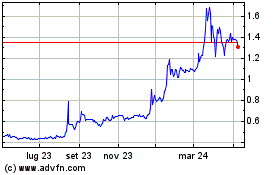Fannie Mae to Send $3 Billion Dividend to Treasury
03 Novembre 2016 - 2:10PM
Dow Jones News
Fannie Mae said it would send a $3 billion dividend payment to
the U.S. Treasury in December as revenue declined in its latest
quarter, but profit soared due to accounting benefits and
fluctuating interest rates.
The mortgage-finance company posted net income of $3.2 billion
for the third quarter, up from $1.24 billion a year prior and $2.95
billion in the second quarter. Revenue dropped 4.1% from a year
prior to $5.61 billion.
The increased profit was driven primarily by fluctuating
interest rates, which hurt the value of derivatives Fannie uses to
manage risk. Sister company Freddie Mac on Tuesday posted a
third-quarter profit increase for the same reason.
The percentage of Fannie-backed mortgages more than 90 days
delinquent continued to fall, declining to 1.24% from 1.32% in the
second quarter and 1.59% in the same quarter a year prior.
Fannie reduced its total loss reserves, which is an estimate on
how many probable losses the company has on its books, to $23.1
billion from $24.2 billion last quarter and $30 billion last
year.
The increased profits come as Fannie's and Freddie's regulator
and some lawmakers have expressed concern over their dwindling
capital reserves. Under the terms of the companies' bailout
agreement with the Treasury, they send profits above their
established capital reserve to the government, but these buffers
are slated to wind down to zero dollars by 2018.
So far, that drop in reserves hasn't caused Fannie or Freddie to
require more bailout money. Fannie reported a net worth of $4.2
billion as of Sept 30.
Still, any blip in the housing market or volatility in the
derivatives values could cause Fannie or Freddie to need taxpayer
funds.
In all, after the quarter's dividend, the company will have sent
$154.4 billion to the Treasury, compared with the $117.1 billion
infusion it has received.
Fannie's large increase in profits emphasizes an accounting
quirk that impacts both Fannie's and Freddie's quarterly
profitability.
Fannie and Freddie have large investment portfolios whose
values, like those of all bonds, rise and fall as interest rates
change. The companies use derivatives to hedge interest-rate risk,
but for accounting purposes, the derivatives and other hedging
instruments are valued at a different time than the hedged assets,
causing large profits or losses to appear in the short term.
Fannie Mae took $496 million in fair-value losses in the
quarter, compared with a loss of $2.59 billion in the prior-year
period.
Fannie buys loans from lenders, wraps them into securities and
provides guarantees to make investors whole if the loans
default.
Write to Austen Hufford at austen.hufford@wsj.com
(END) Dow Jones Newswires
November 03, 2016 08:55 ET (12:55 GMT)
Copyright (c) 2016 Dow Jones & Company, Inc.
Grafico Azioni Federal Home Loan Mortgage (QB) (USOTC:FMCC)
Storico
Da Mar 2024 a Apr 2024

Grafico Azioni Federal Home Loan Mortgage (QB) (USOTC:FMCC)
Storico
Da Apr 2023 a Apr 2024
